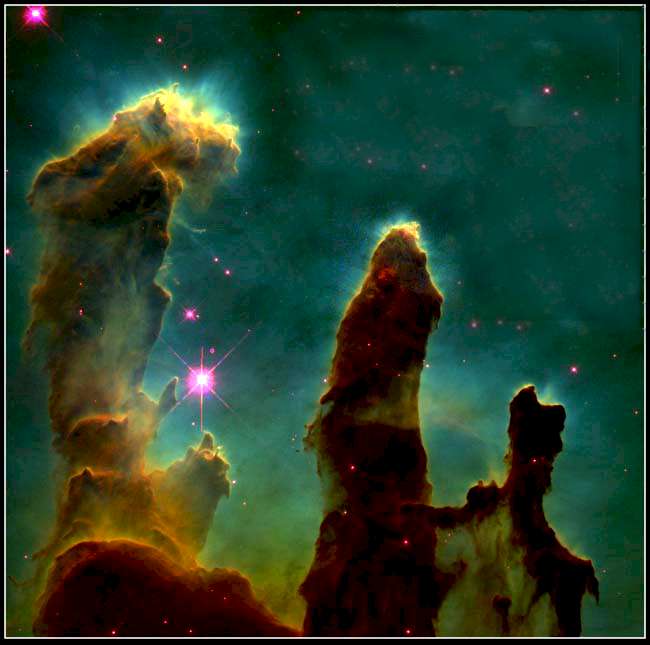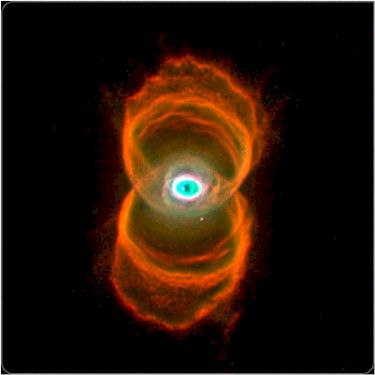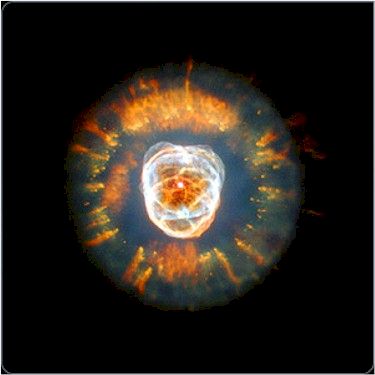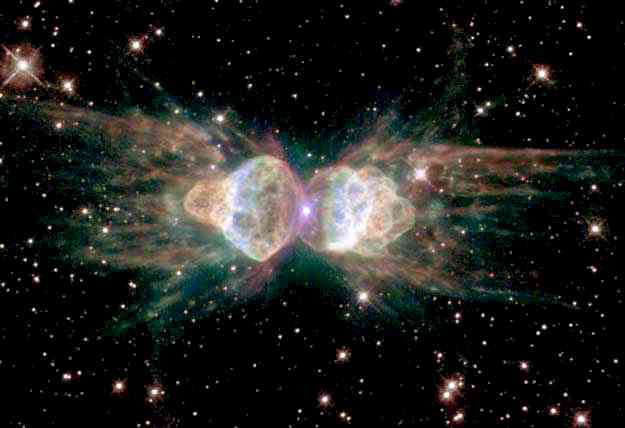When Eagles Lay Eggs
Hubble RevelationsEquipped with his five senses, man explores the universe around him and calls the adventure Science. - Edwin Powell Hubble
Pillars of Creation in a Star-Forming RegionUndersea coral? Enchanted castles? Space serpents? These eerie, dark pillar-like structures are actually columns of cool interstellar hydrogen gas and dust that are also incubators for new stars. The pillars protrude from the interior wall of a dark molecular cloud-like stalagmites from the floor of a cavern. They are part of the "Eagle Nebula" (also called M16 - the 16th object in Charles Messier's 18th century catalog of "fuzzy" objects that aren't comets), a nearby star-forming region 7,000 light-years away in the constellation Serpens. The pillars are in some ways akin to buttes in the desert, where basalt and other dense rock have protected a region from erosion, while the surrounding landscape has been worn away over millennia. In this celestial case, it is especially dense clouds of molecular hydrogen gas (two atoms of hydrogen in each molecule) and dust that have survived longer than their surroundings in the face of a flood of ultraviolet light from hot, massive newborn stars (off the top edge of the picture). This process is called "photoevaporation. "This ultraviolet light is also responsible for illuminating the convoluted surfaces of the columns and the ghostly streamers of gas boiling away from their surfaces, producing the dramatic visual effects that highlight the three-dimensional nature of the clouds. The tallest pillar (left) is about a light-year long from base to tip. As the pillars themselves are slowly eroded away by the ultraviolet light, small globules of even denser gas buried within the pillars are uncovered. These globules have been dubbed "EGGs." EGGs is an acronym for "Evaporating Gaseous Globules," but it is also a word that describes what these objects are. Forming inside at least some of the EGGs are embryonic stars - stars that abruptly stop growing when the EGGs are uncovered and they are separated from the larger reservoir of gas from which they were drawing mass. Eventually, the stars themselves emerge from the EGGs as the EGGs themselves succumb to photoevaporation. The picture was taken on 1 April 1995 with the Hubble Space Telescope Wide Field and Planetary Camera 2. The color image is constructed from three separate images taken in the light of emission from different types of atoms. Red shows emission from singly-ionised sulfur atoms. Green shows emission from hydrogen. Blue shows light emitted by doubly-ionised oxygen atoms. Source: stsci.edu 2 November 1995 photo STSCI-PRC95-44a; photo credit Jeff Hester and Paul Scowen (Arizona State University) and NASA
I kept this picture of the Eagle Nebula as my screensaver for months. I think it's awesome. Something about it reminds me of a prairie dog village. Prairie dogs that size would have little reason to fear predators...
The Centre of the Universe?
Source: T A Rector NRAO/AUI/NSF and NOAO/AURA/NSF) and B A Wolpa NOAO/AURA/NSF (which stands for National Optical Astronomy Observatory/Association of Universities for Research in Astronomy/National Science Foundation); all rights reserved What's amazing to me about the above photo is that the photo of the Eagle Nebula, shown at the top of this page, huge as it is, is actually only the small centre of this photo - you can find the Eagle Nebula tipped to the left about 45º directly in the middle. Would you like to see an even larger photo of The Centre of the Universe - which shows the Eagle Nebula much more clearly? And here are two others - click on the thumbnails below for a much larger-than-normal images.
More from HubbleNebula Around a Dying Star
The exotic young planetary nebula (or dying star remnant) MyCn18, about 8,000 light-years away, is revealed to be have an hourglass shape with an intricate pattern of "etchings" in its walls. The picture sheds new light on the poorly understood ejection of stellar matter that accompanies the slow deaths of sunlike stars. The Hubble has revealed puzzling and unexpected features in the unfolding scene. Photo by Raghvendra Sahai and John Trauger (JPL), the WFPC2 science team and NASA.
"Eskimo" Nebula
This glowing remnant of a dying, sun-like star, first sighted in 1787, is nicknamed the "Eskimo" Nebula (NGC 2392) because of its resemblance to a face in a fur parka (when viewed through telescopes on the ground). In this January Hubble image, the "fur parka" is shown to be a disk of material embellished with a ring of puzzling comet-shaped objects with their tails streaming outward from the central star. The "face" is a bubble of debris being blown into space by a high-speed blast from the central star. Photo by NASA, the European Space Agency Andrew Fruchter and the ERO team (STScI). Source: washingtonpost.com
Ant Nebula
The Ant Nebula, (planetary nebula Mz3) is being cast off by a star similar to our sun that is, surely, round. Why then would the gas that is streaming away create an ant-shaped nebula that is distinctly not round? Clues might include the high 1000-kilometer per second speed of the expelled gas, the light-year long length of the structure, and the magnetism of the star visible above at the nebula's center. One possible answer is that Mz3 is hiding a second, dimmer star that orbits close in to the bright star. A competing hypothesis holds that the central star's own spin and magnetic field are channeling the gas. Since the central star appears to be so similar to our own Sun, astronomers hope that increased understanding of the history of this giant space ant can provide useful insight into the likely future of our own sun and earth. Photo by R Sahai (JPL) et al, Hubble Heritage Team, ESA. Source: antwrp.gsfc.nasa.gov
Eye of God
This is a real photograph of the Helix Nebula, although it's technically not a single photograph but rather a composite image formed from several photographs taken by NASA's orbiting Hubble Space Telescope and a land-based telescope at the Kitt Peak National Observatory near Tucson, Arizona. This image was NASA's "Astronomy Picture of the Day" for 10 May 2003. The picture's "Eye of God" appellation appears to have been a title coined by an admirer of the photo due to the nebula's resemblance to a human eye, not something designated by NASA. Source: snopes.com See also:
For articles on bacteria, centrioles, chairs, nebulae, asteroids, robots, memory, chirality, pain, fractals, DNA, geology, strange facts, extra dimensions, spare parts,
discoveries, ageing and more click the "Up" button below to take you to the Table of Contents for this Science section. |
 Animals
Animals Animation
Animation Art of Playing Cards
Art of Playing Cards Drugs
Drugs Education
Education Environment
Environment Flying
Flying History
History Humour
Humour Immigration
Immigration Info/Tech
Info/Tech Intellectual/Entertaining
Intellectual/Entertaining Lifestyles
Lifestyles Men
Men Money/Politics/Law
Money/Politics/Law New Jersey
New Jersey Odds and Oddities
Odds and Oddities Older & Under
Older & Under Photography
Photography Prisons
Prisons Relationships
Relationships Science
Science Social/Cultural
Social/Cultural Terrorism
Terrorism Wellington
Wellington Working
Working Zero Return Investment
Zero Return Investment






